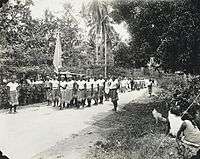Mata'afa Faumuina Fiame Mulinu'u I

Mata'afa Faumuina Fiame Mulinu'u I (died 1948) was a high chief of Samoa and a leader of the country's pro-independence Mau movement during the early 1900s. He became the President of the Mau following the death of high chief and leader Tupua Tamasese Lealofi III in 1929.[1]
He was the holder of high-ranking ali'i chiefly titles, Mata'afa, Fiame from Lotofaga and Faumuina from Lepea. His wife Fa'amusami, was the daughter of paramount chief Malietoa Laupepa.
His son, Fiame Mata'afa Faumuina Mulinu’u II (1921–1975) became the first Prime Minister of Samoa at the country's independence from New Zealand colonial administration.[1] His granddaughter, Fiame Naomi Mata'afa is a high-ranking chief and a long serving cabinet minister in the Samoan government.

As a leader of the Mau, he was one of the wounded[2] during a peaceful Mau procession in the capital Apia on 28 December 1929 when New Zealand police fired into the crowd and resulting in a day of violence that saw up to 11 Samoans and a New Zealand constable killed.[3] The date is referred to as Black Saturday in Samoa's history.
See also
- History of Samoa
- Mata'afa
- Fa'amatai, chiefly system of Samoa.
References
- 1 2 Tuimalealiʻifano, Morgan A. (2006). O tama a ʻāiga: the politics of succession to Sāmoa's paramount titles. University of the South Pacific. p. 23. ISBN 982-02-0377-5. Retrieved 21 February 2010.
- ↑ "Tapuitea, Historical Notes" (PDF). Government of American Samoa. Vol. 3, No.50. Archived from the original (PDF) on October 7, 2009. Retrieved 21 February 2009.
- ↑ http://www.nzhistory.net.nz/politics/samoa/rise-of-mau